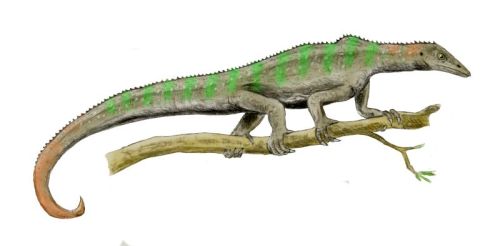
| Archosauromorpha | ||
| The Vertebrates | Drepanosauridae |
| Vertebrates Home | Vertebrate | Vertebrate |
|
Abbreviated Dendrogram
Diapsida
├─Lepidosauromorpha
│
└─Archosauromorpha
╞═"Protorosauridae"
└─┬?─Choristodera
├?─Chelonii (molecular phylogeny)
├?─Helveticosaurus
└─┬─Rhynchosauria
└─┬─Trilophosauria
└─┬─Prolacertiformes
├─Drepanosauromorpha
│ ├─Hypuronector
│ └─Elyurosauria
│ ├─Vallesaurus
│ └─Drepanosauridae
│ ├─Dolabrosaurus
│ └─Megalancosaurinae
└─Archosauria
|
Contents
Overview |
 |
| Life restoration of Megalancosaurus preonensis, a specialised Drepanosaur from the Late Triassic (Middle Norian) of European Tethys (Northern Italy). Length about 25 centimeters. Illustration by Nobu Tamura (Wikipedia). |
The above text is adapted from Wikipedia - MAK
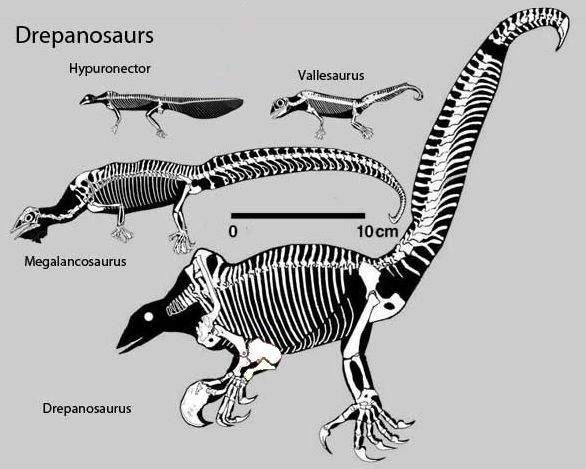 |
| Drepanosaurs drawn to scale; artwork by David Peters |
The Drepanosaurs are a group of specialised archosauromorphs notable for their distinctive, triangular toothless skulls, which resemble the skulls of birds. This similarity to birds may have led to the possible mis-attribution of a drepanosaurid skull to the would-be "first bird", Protoavis. (Renesto, 2000). In fact, they were more chameleonthan bird-like, featuring a suite of bizarre, almost chameleon-like skeletal features. Above the shoulders of most species was a specialized "hump" formed from fusion of the vertebrae, possibly used for advanced muscle attachments to the neck, and allowing for quick forward-striking movement of the head (perhaps to catch insects). Many had derived hands with two fingers opposed to the remaining three, an adaptation for grasping branches. Some individuals of Megalancosaurus (possibly exclusive to either males or females) had a primate-like opposable toe on each foot, perhaps used by one sex for extra grip during mating. Most species had broad, prehensile tails, sometimes tipped with a large "claw", again to aid in climbing. These tails, tall and flat like those of newts and crocodiles, have led some researches to conclude that they were aquatic rather than arboreal. In 2004, Senter dismissed this idea, while Colbert and Olsen, in their description of Hypuronector, state that while other drepanosaurs were probably arboreal, Hypuronector was uniquely adapted to aquatic life. Colbert & Olsen 2001. However it may also have been arboreal, using the deep tail for intra-specific display
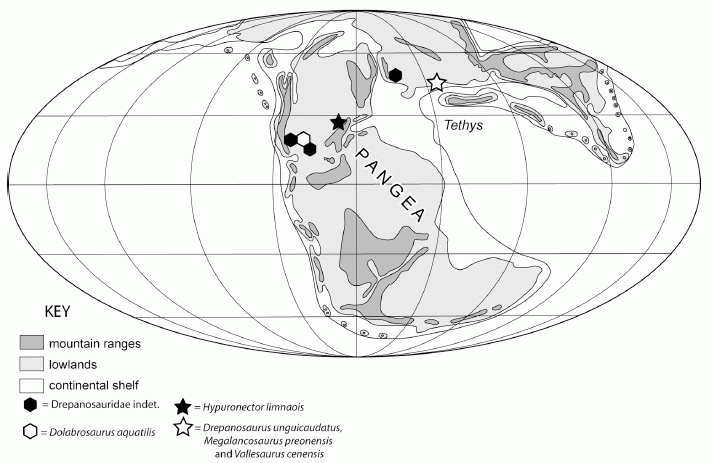 |
| Paleogeographic map of the Late Triassic, with drepanosaurid localities highlighted, from Renesto et al 2009 p.316. Drepanosaurs seem to be predominate in northern Pangea; at the time of writing none have been found South of the equator, although this may simply be an artifact of preservation. So far they are known from the Carnian to Norian (late Triassic) of northern Italy, England, Arizona, New Mexico, New Jersey, |
The highly specialised nature has made understanding where they belong on the diapsid family tree difficult. Renesto, 1994 assigned the drepanosaurids and Longisquama to the Prolacertiformes. Senter 2004 however found them to form a group with the coelurosauravids, for which he coined the name Avicephala, as a sister taxon to Neodiapsida (the group which includes all modern diapsids and their extinct relatives).
Within Avicephala, Senter created the group Simiosauria to refer to all the species traditionally grouped together within the Drepanosauridae, reserving that name for a more exclusive sub-group. Senter found that Hypuronector, originally described as a drepanosaurid, actually lies just outside that clade, along with the primitive drepanosaur Vallesaurus. He also recovered a close relationship between the drepanosaurs Dolabrosaurus and Megalancosaurus. The following cladogram was found by Senter in his 2004 analysis.
Renesto et al. 2010 demonstrated that Senter (2004) cladogram was based on poorly defined characters and dataset. The resulting phylogeny was therefore very unusual compared to any other previous study on drepanosaurs or related taxa. The new cladogram proposed in this last study abandoned both Avicephala (because it is polyphyletic) and Simiosauria, redefining the latter under the PhyloCode as Drepanosauromorpha. Drepanosauromorphs are closely related to the Prolacertiformes, especially genera like Langobardisaurus and Macrocnemus, if not part of the Prolacertiformes. Among the drepanosauromorphs it was defined a more inclusive taxon, Elyurosauria ("lizard with coiled tails"), was erected, in order to include all the drepanosaurs with coiled tails, Vallesaurus is thus more derived than Hypuronector (as clearly shown by its morphology). Drepanosaurus and Megalancosaurus are also in a new taxon named Megalancosaurinae. The alternative cladogram presented in Renesto et al. (2010) is followed here.
We have adopted this phylogeny and assume that the Avicephala are the result of convergence among Permo-Triassic aboreal or gliding forms.
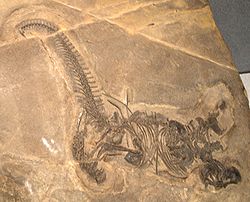 |
| Drepanosaurus unguicaudatus, from the Museo di Storia Naturale di Bergamo, showing the curled tail that is the defining feature of the Elyurosauria ("lizard with coiled tails"). Photo by Ghedoghedo, Wikipedia |
Late Triassic (early Late Carnian to Late Norian) of Europe and North America.
Archosauromorpha ::: Archosauriformes + * : Hypuronector + Elyurosauria
Comments: from Wikipedia: specialized adaptation toward climbing, especially on narrow supports such as the twigs of trees (Renesto, 2000). highly modified cervical vertebrae with adaptations that limited lateral mobility. Both structures indicate the presence of powerful muscles and ligaments for the extension of the neck. This possibly suggests a projectile feeding adaptation (Renesto, 2000). The head was suddenly launched forward to catch prey and the limited lateral mobility prevented undesired jerks of the neck which could have dislocated the cervical vertebrae during the quick extension. In smaller drepanosaurids like Megalancosaurus and Vallesaurus, such adaptations may be related to an insectivorous diet. The teeth of Drepanosaurs such as Vallesaurus seem well suited to cut or crush the tough exoskeleton of insects and other arthropods.Renesto & Binelli 2006
Links: Monkey Lizards of the Triassic - An illustrated article on drepanosaurs from HMNH; Images and discussion of Drepanosaurus and Images and discussion of Megalancosaurus by Silvio Renesto.
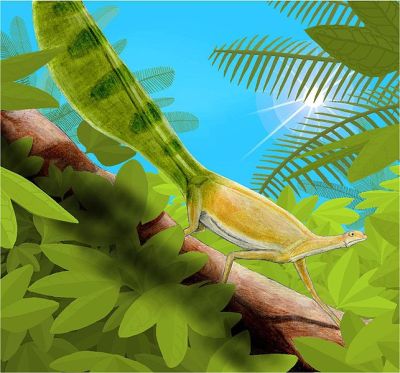 |
| Restoration of Hypuronector limnaios, showing possible arboreal behavior. Length about 12 centimeters. Artwork by Smokeybjb, Wikipedia |
Hypuronector: Hypuronector limnaios Colbert & Olsen 2001
Latest Carnian (Adamanian) of N Am (New Jersey)
Drepanosauromorpha : Elyurosauria + *.
Comments: The oldest well-known Drepanosaur, although indeterminate remains are slightly older (early Adamanian) Renesto et al 2009. The tail of this genus is very deep and non-prehensile, and may have been used as a swimming organ Colbert & Olsen 2001; the name means "deep-tailed swimmer from the lake". Alternatively and equally or perhaps more plausibly, this may have been an aboreal form (see illustration at right). Hypuronector is conventionally placed near the base of the Drepanosaur tree. But it may also be that like some other aquatic forms it may have secondarily taken on more primitive characteristics
Links: Wikipedia MAK101008
Known from the Norian of Europe and North America
Drepanosauromorpha : Hypuronector + * : Drepanosauridae + Vallesaurus.
Comments: chameleon-like arboral forms with prehensile tails. MAK101008
Vallesaurus: V. cenenis (type species), V. zorzinensis.
Late Triassic (Middle Norian) Zorzino Formation of the Italian Alps
Elyurosauria : Drepanosauridae + *.
Comments: Adapted from Wikipedia: A small drepanosaurid about 15 centimetres (5.9 in) long. It is pentadactyl, with the 4th digit being longest and equal in length to the humerus. Its tarsus has a centrale, or an ankle bone which articulates with the tibia. In addition, Vallesaurus also has modified distal tarsals and metatarsals, and a clawless hallux. Renesto & Binelli 2006.
The hand has no opposable fingers; however, the shape and length of the fingers suggest good climbing abilities. (Unwin et al 2000).
The first specimen of Vallesaurus cenensis, MCSNB 4751, was found in 1975 by the staff of the Museo Civico di Scienze Naturali of Bergamo, Italy. The genus was named in respect of professor Valle, the former director of the museum. The species, on the other hand, was named after a local municipality called Cene neighbouring the site where the fossil was excavated. The specimen was given to palaeontologist Rupert Wild to study at the Staatliches Museum of Stuttgart, Germany. Wild named the genus in 1991. Renesto & Binelli 2006
Vallesaurus differs in some characteristics from another drepanosaur, Megalancosaurus. Vallesaurus has a proportionally shorter and higher snout, a thicker and larger maxilla and set of maxillary teeth, and a shorter cervical vertebra. It also lacks the fusion between the neural spines of the second and third dorsal vertebrae. Vallesaurus differs from Drepanosaurus, another drepanosaur, in that it lacks the enormous claw found on the second digit of the manus. It can be distinguished from Drepanosaurus, Megalancosaurus and possibly Dolabrosaurus in the lack of a terminal spine at the end of the tail. In addition, Vallesaurus also differs from Hypuronector, a related drepanosaur, in having anteroposteriorly extended neural spines of the anterior dorsal vertebrae and forelimbs much shorter than the hindlimbs.Renesto & Binelli 2006
Drepanosauridae Berman & Reisz 1992 : Dolabrosaurus, Drepanosaurus, Hypuronector, Megalancosaurus .
Norian of Europe and North America
Elyurosauria : Vallesaurus + * : Dolabrosaurus + Megalancosaurinae.
Dolabrosaurus: Dolabrosaurus aquatilis Berman & Reisz 1992.
Late Triassic (Middle Norian) Chinle Formation of north-central New Mexico
Drepanosauridae : Megalancosaurinae + *.
Comments: Described on the basis of portions of the vertebral column and partial fore- and hindlimbs of a single specimen and found to be similar to Drepanosaurus. The two species were made the basis of the family Drepanosauridae, with Dolabrosaurus more primitive in certain aspects of its vertebral and pedal morphology. Originally considered amphibious or aquatic Lepidosauromorph, now understood to be (like the other drepanosaurs) an aboreal archosomorph.
References: Berman & Reisz 1992.
Links: Wikipedia MAK101008
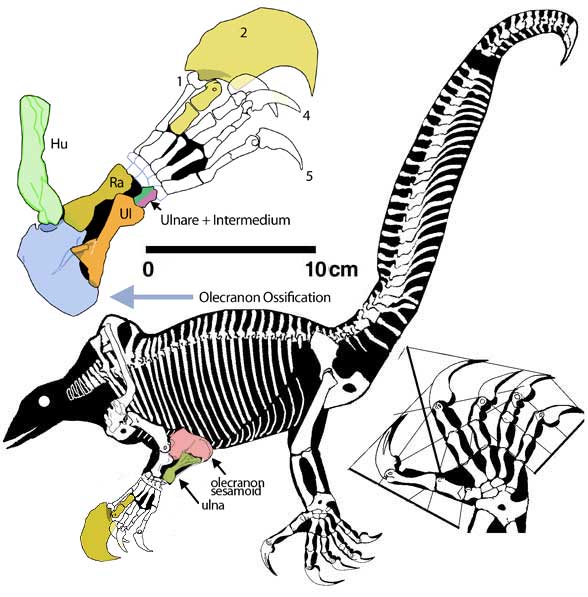 |
| Drepanosaurus unguicaudatus (Pinna 1980) - The scapula was relatively robust with a 70 degree bend at the bottom. The humerus and radius were short and robust. The ulna was replaced by the ulnare and shifted to the elbow where it became disc-like, unlike any other tetrapod. Apparently this was related to the enlarged ungual on digit II which would have required a large muscle, perhaps for digging through tree bark. Graphic and text by David Peters |
Megalancosaurinae: Drepanosaurus unguicaudatus, Megalancosaurus preonensis .
Late Triassic (Middle Norian) Zorzino Formation of the Italian Alps
Drepanosauridae : Dolabrosaurus + *.
Comments: The most highly derived (specialised) drepanosaurs; note the unique climbing claw in Drepanosaurus (right).
References: Calzavara et al 1980, Renesto, 1994.
Links: Wikipedia MAK101008
checked MAK101008
Using this material. All material by ATW is public domain and may be freely used in any way (also any material jointly written by ATW and MAK). All material by MAK is licensed Creative Commons Attribution License Version 3.0, and may be freely used provided acknowedgement is given. All Wikipedia material is either Gnu Open Source or Creative Commons (see original Wikipedia page for details). Graphics and quoted text by David Peters copyright © After 5, used with permission. Other graphics are copyright their respective owners